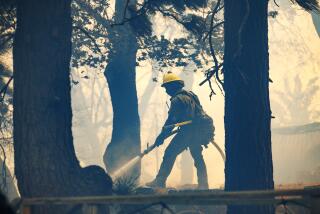Despite Fires, Tribes Aim to Save Sanctity of Sacred Sites
TAOS PUEBLO, N.M. — Leaders of the historic pueblo here made a special request when a wildfire raged nearby last month -- they specifically wanted American Indian firefighters to protect their watershed and other sacred land from the encroaching flames.
It meant sending in battalions of Indian firefighters armed only with hand tools to keep the flames from reaching the Rio Pueblo. Bulldozers and air tankers loaded with fire retardant were directed away from the stream.
“It gave us a level of comfort that eased the tribal government’s concern about having people in areas that are very sensitive culturally,” said Mark Lujan, a spokesman for the pueblo.
With drought conditions persisting and wildfires springing up throughout the West, the possibility of sacred sites being consumed by fire is a worry for Indian communities.
Fires have burned more than 36,500 acres of Indian land in New Mexico and Arizona alone, including more than 5,300 acres at Taos and 24,700 on the Ft. Apache reservation in Arizona.
The Colville and Spokane Indian reservations in Washington and the Crow and Northern Cheyenne reservations in Montana also have dealt with wildfires this summer.
In all, federal fire officials say more than 212,000 acres of tribal land have burned this year.
Indian communities around the nation feel an intimacy with their land and a connection with nature. As Nambe Pueblo Gov. Tom Talache says, “It’s all we have and we don’t want to have it impacted in a negative way.”
That feeling is why tribes sometimes request Indian firefighters.
Tribes have no guarantee that their land will be safe in the hands of Indians, but it’s reassuring to have crews who have a vested interest in the land, said Ben Nuvamsa, superintendent of the Bureau of Indian Affairs’ Fort Apache Agency in Arizona.
Nuvamsa knows firsthand about wildfire’s unpredictable behaviors. He watched as the Rodeo-Chedeski fire roared through the Fort Apache reservation, eating up sacred Apache sites and valuable timber stands. An eerie orange glow formed over the mountains as the fire become more intense.
“It was very scary,” he said.
John Waconda, forester for the BIA’s Southwest Region, said it’s common for tribes to ask for Indian firefighters when cultural sites are threatened.
He also said requests are sometimes made to have Indian firefighters on hand when tribes are performing ceremonies at times of high fire danger.
“They understand the need to be sensitive,” Waconda said. “They have similar values and are able to interpret and comprehend the necessity to be sensitive in certain areas.”
Fire management officials say requests are usually easy to meet, except when fire season is at its peak and resources are spread thin.
“If Indian firefighters are not available, they’re not available,” said Ron Matt, a BIA coordinator stationed at the Southwest Coordinating Center in Albuquerque. “I tell them the fire’s not going to wait for you to make up your mind.”
For Indian firefighters, battling flames on tribal lands takes the same concentration and teamwork as fighting fires elsewhere.
“They give us an assignment to do. We just go in there and do our jobs,” said Gerald Noche, a Zuni tribal member who has been fighting fires for 20 years.
Noche and the other Indian firefighters who were sent to Taos last month did just that.
With help from water-dropping helicopters, they stopped the fire from advancing into the watershed while non-Indian crews built dozer lines on the southern side of the fire to protect hundreds of homes in Taos Canyon.
For the people of Taos, it was hard to watch the black plume of smoke tower above a pueblo that has survived everything from Spanish invasion in the 1540s to a rebellion against the federal government in 1847.
Pueblo member Vernon Lujan said the intimacy that Indians have with the land was evident when lightning sparked the Encebado Fire on Independence Day.
“If you could have been there that Fourth of July,” he said. “My wife and daughter were looking at the fire with tears in their eyes. They were saying, ‘Why us?’ ”
The answer he gave them: Fire is one of nature’s ways of cleaning.
The Taos people have used the Rio Pueblo for centuries. They believe the tribe was created out of the sacred water of Blue Lake, which feeds the small stream.
At Nambe Pueblo to the south, Talache is still reeling from the effects of a wildfire that spread from the Santa Fe National Forest onto tribal land in July and sent ash into the tribe’s lake.
“It was like something out of a Stephen King novel. I never would have imagined seeing the beauty of our lake like this,” he said after describing how crows are feeding on the dead fish that are washing ashore.
Talache said Nambe’s religious leaders have been busy assessing damage done to several sacred sites in the mountains above the pueblo.
Rain is still washing down charred debris from the hillsides at Nambe, but in Taos oak and grass shoots are beginning to peek through the blackened earth. Pueblo leaders are hopeful the winter and spring will renew their sacred land.
Vernon Lujan of Taos said he was asked during the Encebado fire whether the pueblo thought it was more important to put out the fire or protect sacred land.
His answer: “Well, both. You can’t compromise one for the other.”
More to Read
Sign up for Essential California
The most important California stories and recommendations in your inbox every morning.
You may occasionally receive promotional content from the Los Angeles Times.










